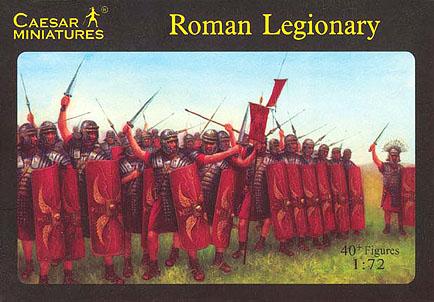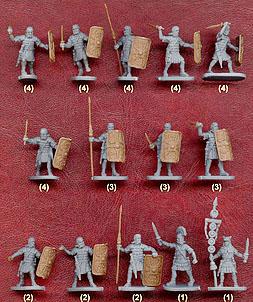Roman Legionaries--41 figures in 14 poses--AWAITING RESTOCK.
$12.99
Future Release
Out of Stock
Add to Wish List Notify Me When Available
Item Number: H041
Roman Legionaries
41 figures in 14 poses
No-one knows why today, but early in the first century CE Roman soldiers, or at least those in the west, began to be issued with a new plate armour to replace their coats of mail, and so an icon was created. This armour, named lorica segmentata in modern times, has become the most recognisable aspect of a Roman soldier, and consequently is much the most popular for model figures such as these from Caesar.
All the soldiers in this set are dressed in this fashion, and a very good job has been done in depicting it. They have helmets in the Imperial Gallic style, but there is no sign of any cross reinforcement over the crown, which appears late in the first century. Also the helmets have no crest and the sword is held in a scabbard on the right hip (a dagger appearing on the left). All this tells us that these figures are suitable for the last three quarters of the first century and probably the early years of the second.
All the legionary figures have ring hands to accommodate the separate weapons, and all bar one have a peg on their left arm to allow the fixing of a shield. The weapons, which are provided on a number of separate sprues, fit the ring hands very well without any need for glue. From the pictures it is easy to see that many of the ring hands are not facing the mould, which is more difficult to manufacture but results in a much better pose for the figure. The set includes 39 figures with ring hands and five of the separate sprue, delivering 25 pila and 15 swords. You can largely please yourself as to who carries what, although some of the men have empty scabbards which suggests they should be carrying the swords. We mostly used swords for two reasons. First, they make the figure easier to photograph, and second, the pila are much too large - or at least they were when this set was first released. Beautifully and delicately done to be sure, but the examples in the first batch all measured 35 mm, which is a massive 2.5 metres in length. While actual lengths varied somewhat, most were a maximum of two metres, or a little taller than the man himself. Those in the first type of this set were more like pikes as can be seen above, and would be very hard to throw or wield in battle. Happily Caesar recognised this problem (perhaps they read our review) and subsequently this set appears with the same sprue but with shortened pila as seen here. They are now a much more realistic 28 mm in length - at the top end of acceptable, but a great improvement on the first batch. Of course, which sort you will find in any set you buy will be unpredictable, but hopefully the over-long examples will gradually disappear off the shelves.
Also on the separate sprues are the shields. These are rectangular and curved around the hand and fit onto a peg on the arm. Apart from the third figure in the bottom row, who is resting with his shield, all the men carry theirs on their arm, but the centurion should also have a shield which he does not. The fit on the peg is not snug so gluing is necessary, but having a separate shield does allow much more realistic poses. The shields are of the correct size and are engraved with two slightly different designs, both of which are authentic.
The Romans are famous for their disciplined formations, but these figures are no good for that. Instead we see a large number of poses of men apparently fighting once the formation has broken up, which surely it would have frequently done. Most hold their shields in front of them as they thrust with their weapon, which is exactly what you would expect, so we really liked all the poses.
The two special figures are at the end. First we find a centurion, unmistakable with his transverse helmet crest, greaves on his legs and the reversed sword/dagger - all symbols of his rank. He appears to have a mail coat, which is OK, but as we have said he should have a shield if in battle. Beside him is the signifier carrying the century's signum, which is of typical design. The man wears an animal pelt (a wolf?) which was very common, and holds a sword in his left hand, perhaps more symbolically than genuinely ready for combat. Still both he and the centurion are very fine.

